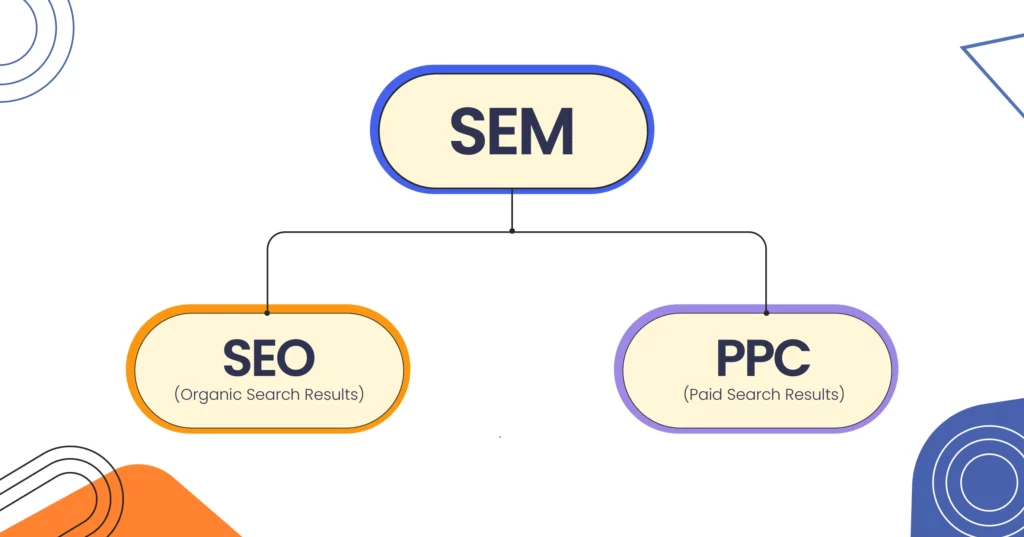The What, Why, & How of SEO vs SEM for Your Brand
Search, Click, Explore! Online experience begins with a search and a search engine.
Search engines like Google and Bing are renowned for bringing your products or services into the limelight from your target audience.
Both SEM and SEO focus on obtaining traffic from search engines. SEO does this organically (unpaid version), whereas SEM does it by combining paid search (PPC) and SEO for a combined effect. Read on to learn their benefits, similarities, and differences.
What is SEO
SEO, basically Search Engine Optimization, is the practice of enhancing your website’s visibility on search engines. The main goal is to improve your website’s rank in search results, making it highly probable for people to find and click on it. This involves optimizing content, using suitable keywords, and providing a user-friendly website structure. SEO helps search engines understand your website’s relevance to user queries and drive traffic organically to your web pages.
Tekglide’s SEO consulting services boost website traffic, conversions, and sales. Our approach promotes search engine rankings and attracts more clients, demonstrating greater authority for your website.
Types of SEO
While SEO is one term but actually, it’s a tree with many types of branches sheltering under it. Understanding and executing various types of SEO can improve a website’s online presence and search engine rankings.
- On-Page SEO: On-page SEO requires optimizing individual web pages to improve search engine rankings. It involves including optimized content, meta tags, and HTML elements, ensuring keyword relevancy for a positive user experience.
- Off-Page SEO: Off-page SEO basically refers to activities outside your website to enhance its visibility. It includes building quality backlinks, engaging users through social media, and online reputation management to boost and build credibility.
- Technical SEO: Technical SEO focuses on the website’s structure by ensuring it is readable by search engines. It includes optimizing speed, improving crawlability, and enhancing the technical aspects to provide a smooth experience for users and search engines.
- Local SEO: Local SEO increases visibility for businesses in local searches. It concerns optimizing Google My Business profiles, getting positive reviews, and providing accurate business information for an enhanced local presence and attracting nearby customers.
- Mobile SEO: Mobile SEO revolves around optimizing websites for mobile devices. It includes responsive design, fast loading times, and understandable content to provide a prime user experience.

What is SEM
Search Engine Marketing, or SEM, is a digital marketing strategy that focuses on increasing a website’s visibility in search engine results through paid advertising. SEM applies to paying for ads to appear on search engine results pages (SERPs). Typically associated with platforms like Google Ads, SEM allows businesses to bid on keywords related to their products or services. It ensures their ads are shown to users who are searching for relevant keywords. SEM aims to drive traffic to a website and increase sales through paid search advertising.
Start your campaign immediately with Tekglide’s assistance, your go-to search engine marketing agency in the USA. Our company uses SEM strategies to improve search visibility and ensure results.
Benefits of SEM
- SEM helps in immediate visibility for your business on search engine results pages with ads shown to users actively searching for products or services.
- SEM lets you target specific keywords relevant to your business and to an audience interested in your offerings.
- SEM platforms provide clear analytics, allowing you to track and measure the performance of your ads. You can review clicks, impressions, and conversions of your campaigns.
- With SEM, you can set a campaign budget, adjust bids, and allocate resources based on performance.
- SEM provides a targeted approach that increases the users’ desired actions, such as making a purchase or filling out a form.
Differences between SEO vs SEM
The contrast between SEO vs SEM is that SEO concentrates on optimizing your website for higher rankings and traffic in organic search results. In contrast, SEM focuses on organic and paid search optimizations and approaches for earning higher rankings and boosting visibility.
Let’s understand the key contrast, it’s important to note that Google’s search results are formed of two main categories — the organic search and the paid search results.
SEO aims to get your website’s rank to increase in the organic search results. Organic search results happen to be those websites that appear below the sponsored websites. In other words, you have to pay to rank in the organic results.
While on the other hand, for SEM the goal is to get your website to rank higher in organic and paid search results. Paid search results are those which are the first three websites appearing when you search, identified by the “sponsored” title above the page title.
Paid search is referred to as pay-per-click (PPC) advertising. So, SEM is a broad term that incorporates SEO and PPC, meaning that SEO falls under the umbrella of SEM.
Factor | SEO | SEM |
| Traffic Cost | Free | Typically paid |
| Marketing Type | Inbound | Outbound and Inbound |
| Time To Results | Long term | Short and long term |
| Included Channels | SEO | PPC, SEO, Display, Local & more |
| Targeting | No | Yes |
How do SEM and SEO work together?
SEO and SEM work together to improve search engine rankings. A healthy SEO-optimized website with high-quality content and user experience can help with a higher Quality Score, which can impact the performance of your SEM campaigns.
SEO and SEM both involve keyword targeting through different means. Aligning the keywords targeted in SEO efforts with those used in SEM campaigns helps reinforce brand messaging, improve user experience, and maximize overall search visibility.
While SEM provides visibility through paid ads, maintaining an organic presence through SEO proves to be effective in the long run. A well-optimized website that ranks high organically while spending on ads.
It is a cohesive digital marketing strategy, allowing businesses to effectively cover organic and paid search channels. The strengths of both approaches are maximizing online visibility, attracting qualified traffic, and achieving their marketing objectives more efficiently.
How long does it take to see results?
SEO and SEM have specific differences but when it comes to how long SEO and SEM take, that depends on the brand and the strategies taken around. But according to Tekglide:
- SEO: Takes around six months
- SEM: Happens to be as soon as your ads launch
There are many factors that can affect the time period for results.
For example, your SEM campaign may not deliver results right away. Instead, it may need a few weeks of advertising and A/B testing data to improve your reach to improve your conversion rates. Or, your SEO campaign may need even more time due to fixing crawling and indexing issues from an SEO audit.
Conclusion
As businesses grow and consumer behavior changes, integrating SEO and SEM becomes a strategic choice alongside a necessity for brands. Combining organic and paid strategies helps brands reach a broader audience, drive traffic, and achieve growth.
The ‘What, Why, & How’ of SEO vs SEM is not a choice between one or the other; it’s an embrace of both to harness their collective potential for brand success. Tekglide balances the long-term benefits of SEO with the immediate impact of SEM, helps brands navigate the complexities of online visibility, and adapts and secures a prominent position in the market.





